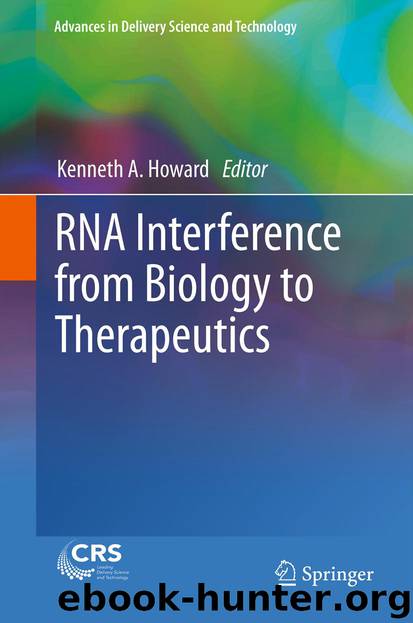RNA Interference from Biology to Therapeutics by Kenneth A. Howard

Author:Kenneth A. Howard
Language: eng
Format: epub
Publisher: Springer US, Boston, MA
8.3 Passive and Active Targeting in Cancer
8.3.1 Passive Targeting
Rapidly dividing cancerous cells require a continuous supply of nutrients to maintain proliferation. Cancerous cells, therefore, secrete growth factors that induce angiogenesis and result in a fast and disordered neovascularization around the tumor area. The new blood capillaries present loose interendothelial junctions that allow enhanced permeability to extravascular tissue. Through this leaky vasculature of the tumor, some substances including polymeric micelles are able to extravasate from the blood vessels to the tumor tissue. Moreover, the development of a lymphatic system is insufficient in tumor tissue, resulting in poor drainage of macromolecular substances from the tissue. This preferential macromolecular accumulation in solid tumor tissue is known as enhanced permeability and retention (EPR) effect [22, 23]. The EPR effect found by Matsumura and Maeda has become the guideline for passive targeting in cancer.
For an effective passive accumulation by the EPR effect, the nanocarriers should be small enough to permeate through the gaps in the endothelium from the blood compartment into solid tumors. Secondly, nanocarriers should have long circulation properties. Theoretically, long-circulating nanocarriers have an increased chance to find these gaps between endothelial cells and extravasate to tumor tissue. The long-circulation property is, in fact, a consequence of its stability in the bloodstream, avoiding glomerular excretion by the kidney and nonspecific complement activation and opsonization that could lead to uptake by the MPS in the liver, spleen, and lung. As the renal filtration cutoff is 50 kDa (or 5–6 nm), rapid removal and excretion of particles smaller than this cutoff is expected [24]. On the other hand, larger particles can be recognized and removed by the MPS, resulting in short half-life in the blood [25].
Download
This site does not store any files on its server. We only index and link to content provided by other sites. Please contact the content providers to delete copyright contents if any and email us, we'll remove relevant links or contents immediately.
| Administration & Medicine Economics | Allied Health Professions |
| Basic Sciences | Dentistry |
| History | Medical Informatics |
| Medicine | Nursing |
| Pharmacology | Psychology |
| Research | Veterinary Medicine |
The Poisoner's Handbook by Deborah Blum(2095)
Bottle of Lies by Katherine Eban(1764)
Mycelium Running: How Mushrooms Can Help Save the World by Paul Stamets(1647)
The Vaccine Race by Meredith Wadman(1630)
Missing Microbes by Martin Blaser(1558)
The Doors of Perception and Heaven and Hell by Aldous Huxley & Aldous Huxley(1551)
Pharmacy Practice and The Law by Richard Abood(1544)
Decisive by Chip Heath(1521)
28 Seconds by Michael Bryant(1490)
Steroids: History, Science, and Issues by Standora Joan E.; Bogomolnik Alex; Slugocki Malgorzata(1480)
McGraw-Hill Nurses Drug Handbook by Patricia Schull(1466)
The Doors of Perception: Heaven and Hell (thINKing Classics) by Aldous Huxley(1452)
Ganja Yoga by Dee Dussault(1429)
What's Making Our Children Sick? by Michelle Perro(1385)
Complete Guide to Prescription & Nonprescription Drugs 2014 by H. Winter Griffith(1333)
Stealing Fire: How Silicon Valley, the Navy SEALs, and Maverick Scientists Are Revolutionizing the Way We Live and Work by Steven Kotler & Jamie Wheal(1312)
Anatomy of an Epidemic by Robert Whitaker(1295)
Trip by Tao Lin(1266)
Cannabis for Chronic Pain by Rav Ivker(1203)
